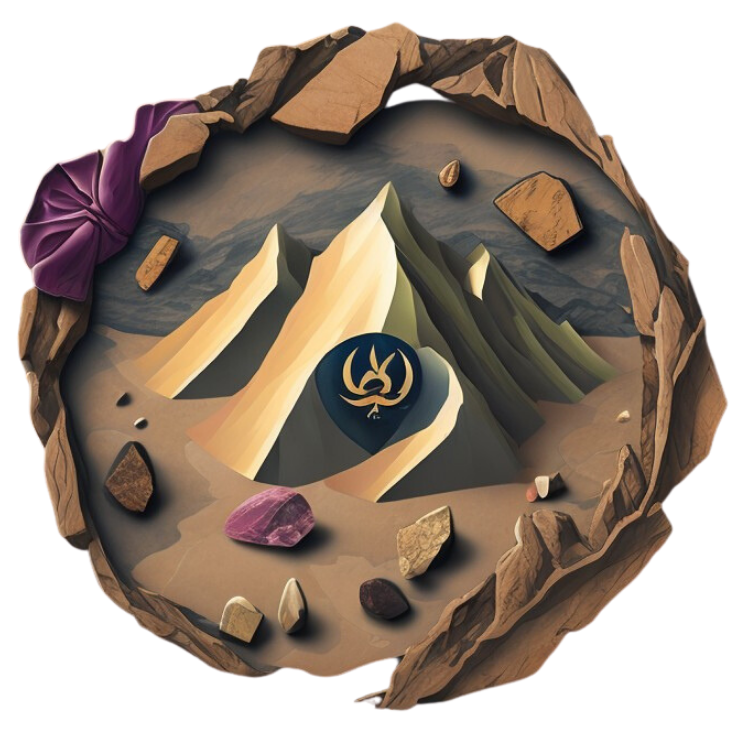Unearth the Unknown: Discover the Best AI-Powered Rock Identifier Apps of 2025
Click here to see our crystal hunting maps
If you've ever been hiking, beachcombing, or exploring a riverbed and stumbled upon a strange, beautiful stone, you've probably had that moment: What is this? Maybe it sparkled under the sun, or maybe its colors looked like they belonged in a museum. But unless you're a trained geologist—or carrying around a backpack of field guides—you were left wondering.
Thankfully, in 2025, identifying rocks is no longer a mystery left to the experts. We live in an age where your smartphone can act like a pocket geologist, using artificial intelligence (AI) to recognize thousands of rock and mineral types in seconds. This technology isn't just for professionals—it's for hikers, students, hobbyists, and anyone with a spark of curiosity about the natural world.
In this guide, we'll take you deep into the world of rock identifier apps, exploring how they work, what's new in 2025, and which ones are worth your time and storage space. Whether you want to name that glittering crystal you found on a trail, catalog your growing mineral collection, or teach your kids about geology in a fun way, you're about to find your perfect digital companion.
From Guesswork to AI: How Rock Identifier Apps Work in 2025
A decade ago, rock identification was almost entirely manual. You'd need to check a field guide, compare photographs, or even run simple chemical tests to get close to an answer. Now, thanks to AI, that's changed.
Most modern rock identifier apps use deep learning—a branch of artificial intelligence trained on massive image datasets of rocks, minerals, crystals, and gemstones. Here's what happens when you take a photo in one of these apps:
- Image Capture — You snap a clear, well-lit picture of the rock.
- Pattern Analysis — The AI scans its visual patterns: color, grain, luster, streak, and crystal shape.
- Database Match — It compares these features to thousands (sometimes tens of thousands) of reference images in its database.
- Result Delivery — Within seconds, you get a likely identification, often with extra details like hardness, composition, origin, and even value estimates.
What's new in 2025 is how fast and accurate these apps have become. Many no longer require constant internet access—offline recognition is now possible thanks to improved mobile processors and compressed AI models. Some even let you store and organize your own rock collection within the app, making them part encyclopedia, part personal museum.
What's New in 2025: The Evolution of Rock ID Apps
The leap from 2023's apps to 2025's is bigger than you might think. Back then, accuracy could be hit-or-miss, especially with less common specimens. Now, a few key trends have transformed the experience:
- Offline Identification — No more losing functionality when you're in the mountains or deep in a canyon. Many apps store AI models locally, so they work even without cell service.
- Community Integration — Apps now let you share finds with other enthusiasts, get expert feedback, and even join geology challenges or scavenger hunts.
- Educational Depth — Beyond naming a rock, apps provide geological history, formation processes, and sometimes even local geological maps.
- Multi-Feature Toolkits — Some apps combine rock identification with other tools like GPS tagging, collection tracking, and even augmented reality overlays that label rocks in your camera view in real time.
These advances make rockhounding more accessible and fun than ever, whether you're ten years old or a seasoned geologist.
The Best Rock Identifier Apps of 2025
After testing dozens of apps on different devices and in different environments, we've narrowed it down to the ones that stand out for accuracy, usability, features, and educational value.
Instead of dumping a list on you, let's explore each one in a way that helps you decide which fits your style of exploration.
1. Stone Identifier: RockHunt (iOS) — The AI Powerhouse for iPhone Users
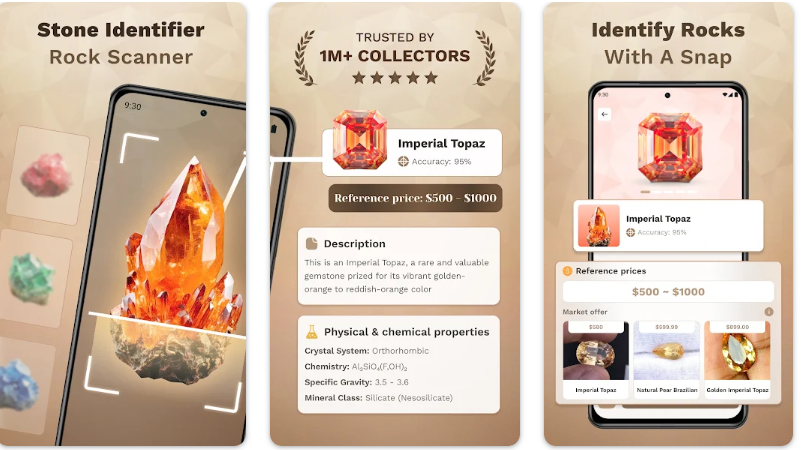
If there's a "gold standard" in 2025, RockHunt might be it. Built for iOS, it combines lightning-fast AI recognition with a sleek, intuitive design.
The moment you open the app, you're guided into snapping your first rock photo. Within seconds, RockHunt identifies the specimen and displays a beautifully designed information card with details like hardness (Mohs scale), mineral composition, and origin.
Why it stands out in 2025:
- Offline mode works flawlessly, making it a true field companion.
- Collection management lets you store photos, notes, and GPS locations.
- Educational modules make it perfect for students and hobbyists alike.
Pros:
- Works perfectly offline
- Lets you store detailed collections with GPS tags and personal notes
- Gorgeous interface with educational modules
Cons:
- iOS only—no Android version yet
If you're an iPhone or iPad user and want the smoothest, most accurate AI rock identification experience, RockHunt is an easy recommendation.
2. Rock Identifier: Stone ID (Android & iOS) — The Cross-Platform Champion
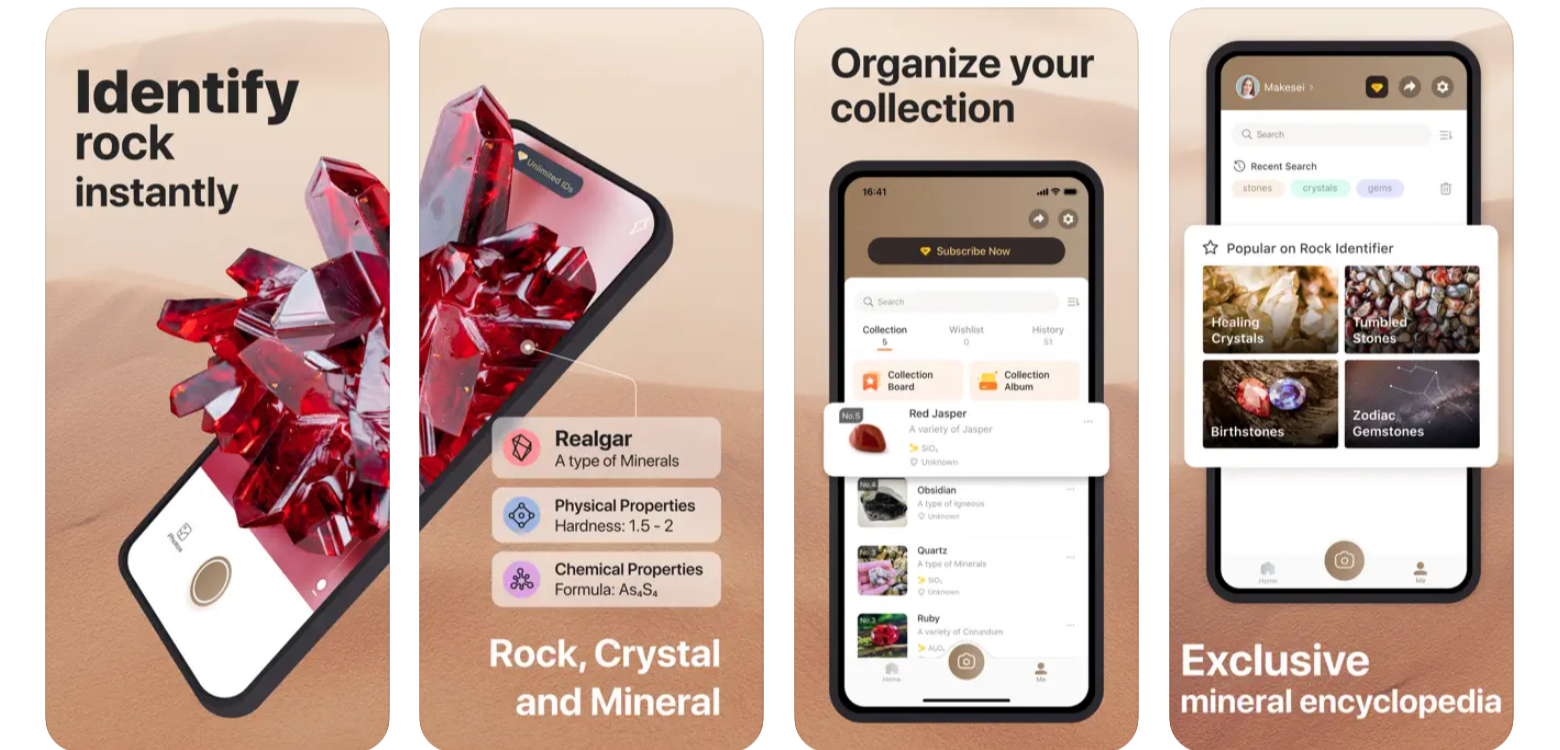
Stone ID has been a favorite for years, and its 2025 update pushes it even further ahead. Available on both Android and iOS, it boasts a massive database of over 6,000 rock and mineral types.
Snap a photo, and you'll get not only an identification but also an array of details: hardness, streak, luster, possible locations where similar specimens are found, and even tips for care if it's a crystal or gemstone.
The app also supports multiple languages, making it ideal for international travelers or students.
Pros:
- Works on both iOS and Android
- Multilingual support for travelers
- Offers care tips for crystals and gemstones
Cons:
- Occasional false positives with heavily weathered stones
3. Rockd — Where Science Meets Social Exploration
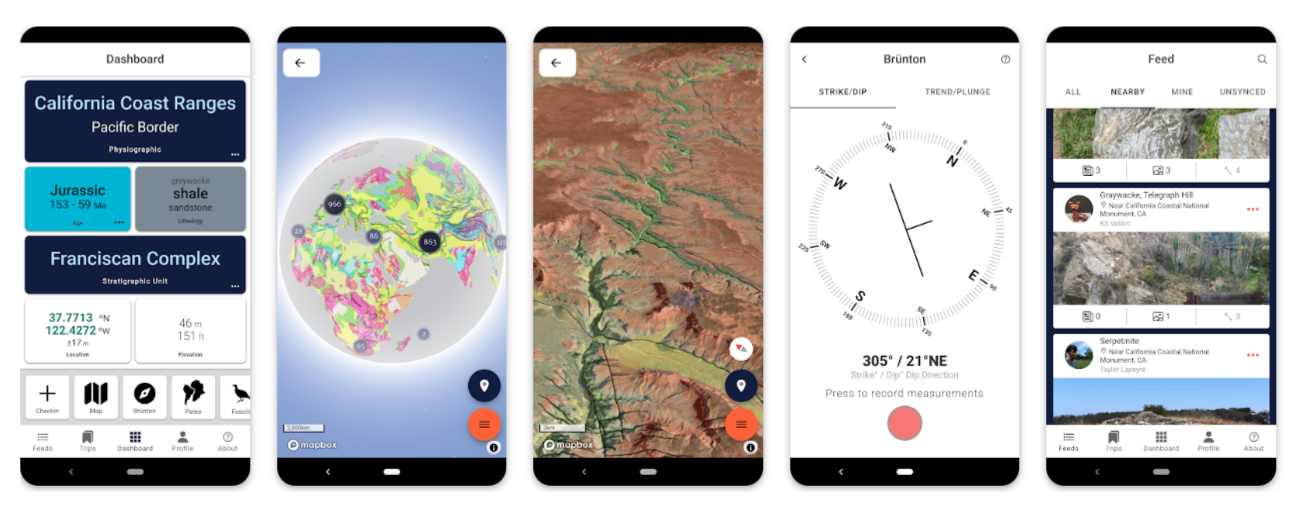
Part rock identification app, part geology social network, Rockd is for those who want to share their discoveries with a community.
Not only can you identify rocks, but you can also pin your finds on a map, join challenges, and see what others have discovered in your area. This makes it a perfect choice for those who see rockhounding as a shared adventure rather than a solitary hobby.
In 2025, Rockd has improved its accuracy engine and introduced AR labels—point your camera at a rock outcrop, and names pop up right on your screen.
Pros:
- Unique AR feature for live labeling of rock outcrops
- Active community for feedback and sharing
Cons:
- Requires internet for some features
Download the Android Version and iOS version.
4. Geology Toolkit — For Students and Professionals

While many apps focus on casual hobbyists, Geology Toolkit is unapologetically aimed at serious users. It's less about instant gratification and more about geological depth—providing tools for measurements, geological maps, field note-taking, and lab analysis support.
If you're a geology student, field researcher, or working professional, this app turns your smartphone into a portable geology lab.
Pros:
- Deep professional features
- Integrates with academic work
Cons:
- Steeper learning curve for casual users
Download the Android version.
5. Stone Identifier Rock Scanner (Free) — A Great Starting Point
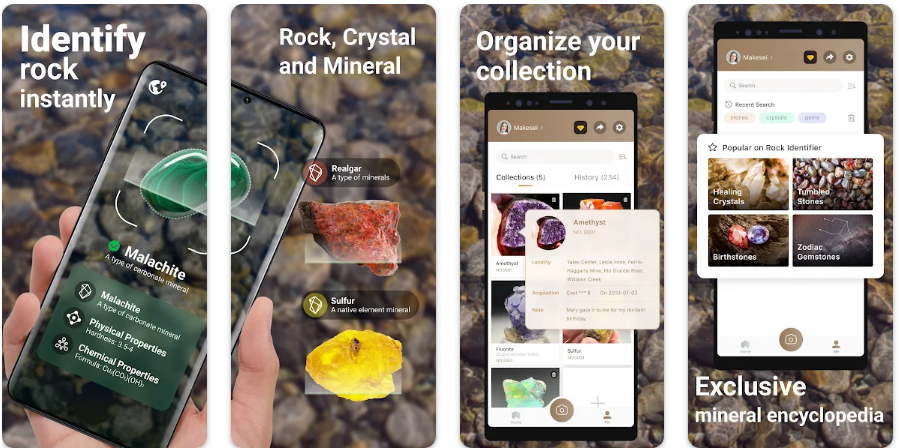
If you're not ready to commit to a paid subscription, the free version of Stone Identifier Rock Scanner is a great entry-level choice. Its database isn't as deep as RockHunt or Stone ID, but it's accurate with common rocks and minerals, making it ideal for beginners, kids, or occasional explorers.
Pros:
- Free entry point
- Simple to use
Cons:
- Limited database depth
Download the Android version and iOS version.
Comparison Table: Best Rock Identifier Apps (2025)
| App | Platforms | Offline Mode | Database Size | Community Features | Best For |
|---|---|---|---|---|---|
| RockHunt | iOS | Yes | ~5,000+ | Moderate | iOS users seeking accuracy |
| Stone ID | iOS, Android | Yes | 6,000+ | Minimal | Cross-platform collectors |
| Rockd | iOS, Android | Partial | 4,000+ | Strong | Social rockhounds |
| Geology Toolkit | iOS, Android | Yes | N/A (tool-based) | Minimal | Students/pros |
| Rock Scanner (Free) | iOS, Android | No | 1,000+ | None | Beginners |
How to Choose the Right Rock Identifier App for You
Choosing the right app comes down to asking yourself a few questions:
- Do you need it to work offline in remote areas?
- Are you looking for social features to connect with other rockhounds?
- Do you care more about speed or depth of information?
- Will you use it for learning or simply quick identifications?
Your answers will determine whether you should go for a casual-friendly app like Rockd, an AI powerhouse like RockHunt, or a professional toolkit like Geology Toolkit.
RELATED READ: The Best Tools for Gem Mining: Essential Equipment & Where to Buy Them
Field Accuracy: Why No App is Perfect
Even the best AI can make mistakes. Lighting, angle, dirt, or a specimen's rarity can throw off identification. That's why experienced rockhounds often use these apps as starting points, then verify with field tests or expert advice.
Some quick tips to improve accuracy:
- Take photos in bright, natural light.
- Capture multiple angles, especially if the rock has unique crystal shapes.
- Include a size reference (like a coin) in the shot.
Beginner's Guide: How to Identify Rocks Like a Pro (Even Without Experience)
- Clean Your Specimen — Brush off dirt or debris.
- Find Good Lighting — Natural sunlight works best.
- Capture Multiple Angles — Top, side, and close-up.
- Include a Size Reference — Place a coin or ruler next to the rock.
- Use the App Offline if Possible — Avoid poor reception errors.
- Read the Description — Learn beyond the name.
- Cross-Check — Use a second app or manual test for rare finds.
The Future of Rock Identification Apps
The next frontier? Real-time AR identification that labels rocks as you walk by, AI learning from user corrections, and deeper integration with museum and university databases. We may also see gamification—turning geology into a global treasure hunt.
Conclusion: Every Rock Has a Story
Rocks are the storytellers of the Earth. They hold the history of continents, the memory of ancient oceans, and the secrets of long-extinct volcanoes. With the right app, you can unlock those stories anywhere, anytime.
In 2025, rock identifier apps aren't just tools—they're gateways to curiosity, learning, and adventure. Whether you're kneeling by a stream or trekking through a mountain pass, your phone can now help you see the planet in a whole new way.
So next time you find a rock that catches your eye, don't just pocket it. Photograph it, learn its name, and share its story. Because every discovery, no matter how small, brings you closer to the incredible history beneath your feet.
Extra Resources for Rock Lovers
- Books: National Audubon Society Field Guide to Rocks and Minerals
- Websites: Mindat.org (massive mineral database)
- Communities: Local rockhounding clubs often have Facebook groups or meetups
FAQ: Rock Identifier Apps
1. Do rock identifier apps work offline?
+Many 2025 apps like RockHunt and Stone ID now offer offline modes, storing AI models locally so they work without internet connection—perfect for remote rockhounding locations.
2. How accurate are rock identification apps?
+Top apps achieve 85-95% accuracy with common rocks and minerals. Accuracy depends on photo quality, lighting, and specimen condition. Always use apps as starting points and verify with additional testing for valuable finds.
3. Which rock identifier app is best for beginners?
+4. Can these apps identify gemstones and crystals?
+Yes! Most modern rock identifier apps include extensive gemstone and crystal databases. Apps like Stone ID even provide care tips for crystals and value estimates for gemstones.
5. Are there free rock identification apps available?
+Yes, Stone Identifier Rock Scanner offers a free version with basic identification features. However, premium apps like RockHunt and Stone ID provide more accurate results and additional features for serious rockhounds.
